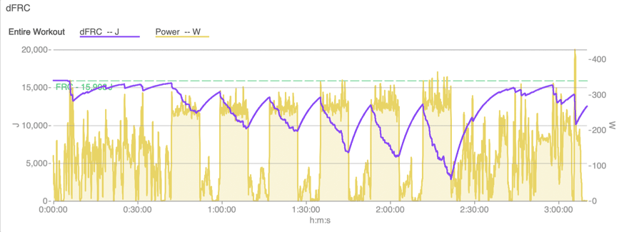Dynamic Functional Reserve Capacity (dFRC) in WKO5
The concept might be best demonstrated in the above screenshot of a 6 x 8-minute supra-FTP workout performed by Jane Rider. The yellow line is Jane’s power output, and we can see that she hit the intervals pretty well and was actually increasing power on each one. The purple line is her dFRC, showing the amount of anaerobic energy drained in each interval. As each interval progresses, she goes a little harder, draining more battery but never fully depleting it. This is a good workout, but it could have been done a little harder as she never really drained the battery fully. As a coach, I would use this analysis to suggest next time she goes a little harder in the earlier intervals, she was holding back too much.
What does it mean if my dFRC goes below zero?
You may have noticed that dFRC can sometimes fall slightly below zero. dFRC modeling is a difficult challenge; we can accurately estimate the burn rate of energy above FTP, but there are large variations in the recovery rate of that energy. In WKO5 your FRC and dFRC are based on your individual power duration curve as estimations of your recovery rate and fatigue.
If your dFRC is going significantly negative, however, this is typically an indicator of an inaccurate power duration model due to lack of testing or maximal efforts. Click here to watch Tim Cusick's webinar on how to maintain your model.
Key Benefits of Measuring dFRC
Now that we can measure dFRC and track how an athlete uses the anaerobic battery in workouts and racing, let’s talk about some of the key benefits of doing so.
- Tracking dFRC allows us to understand how deep the athlete went during workouts and efforts above FTP.
- Reviewing and tracking dFRC in an athlete’s workouts will give insight into specific workout types and targeted intensities that will lead to the optimal workout for that athlete.
- Utilizing dFRC to review races, event performances, and hard efforts will demonstrate how well athletes use their FRC to improve results.
- A better understanding of FRC as reflected in dFRC allows for better race performance. For example, it can help tell me when I should sprint, how hard I can go to establish a break, and if I can power climb that technical hill.
- Team time trial planning can be better timed by using dFRC to determine pull time and intensity.
dFRC and Anaerobic Work Capacity
The idea of dFRC is a new concept, but it’s also an improvement on an existing one. In 2012, Dr. Phil Skiba introduced the idea of W and W’balance. These concepts were based on the Critical Power model designed by Monod and Scherrer in 1965. The idea of W’balance and its uses was an exciting concept and an excellent starting point. WKO uses the Power-Duration Model and some additional elements to improve upon this idea, but credit should still be given to Dr. Skiba for the original idea.
For a more detailed overview of dFRC, watch Tim Cusick's educational workshop webinar below or on YouTube.

